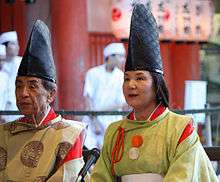Priest


A priest or priestess (feminine) (from Greek πρεσβύτερος presbýteros through Latin presbyter, "elder", or from Old High German priast, prest, from Vulgar Latin "provost" "one put over others", from Latin praepositus "person placed in charge"), is a person authorized to perform the sacred rituals of a religion, especially as a mediatory agent between humans and one or more deities. They also have the authority or power to administer religious rites; in particular, rites of sacrifice to, and propitiation of, a deity or deities. Their office or position is the priesthood, a term which also may apply to such persons collectively.
Priests and priestesses have existed since the earliest of times (see Proto-indo-European trifunctional hypothesis) and in the simplest societies, most likely as a result of agricultural surplus and consequent social stratification. The necessity to read sacred texts and keep temple or church records helped foster literacy in many early societies. Priests exist in many religions today, such as all or some branches of Judaism, Christianity, Shintoism, Hinduism. They are generally regarded as having positive contact with the deity or deities of the religion to which they subscribe, often interpreting the meaning of events and performing the rituals of the religion. There is no common definition of the duties of priesthood between faiths; but generally it includes mediating the relationship between one's congregation, worshippers, and other members of the religious body, and its deity or deities, and administering religious rituals and rites. These often include blessing worshipers with prayers of joy at marriages, after a birth, and at consecrations, teaching the wisdom and dogma of the faith at any regular worship service, and mediating and easing the experience of grief and death at funerals – maintaining a spiritual connection to the afterlife in faiths where such a concept exists. Administering religious building grounds and office affairs and papers, including any religious library or collection of sacred texts, is also commonly a responsibility – for example, the modern term for clerical duties in a secular office refers originally to the duties of a cleric. The question of which religions have a "priest" depends on how the titles of leaders are used or translated into English. In some cases, leaders are more like those that other believers will often turn to for advice on spiritual matters, and less of a "person authorized to perform the sacred rituals." For example, clergy in Roman Catholicism and Eastern Orthodoxy are priests, but in Protestant Christianity they are typically minister and pastor. The terms priest and priestess are sufficiently generic that they may be used in an anthropological sense to describe the religious mediators of an unknown or otherwise unspecified religion.
In many religions, being a priest or priestess is a full-time position, ruling out any other career. Many Christian priests and pastors choose or are mandated to dedicate themselves to their churches and receive their living directly from their churches. In other cases it is a part-time role. For example, in the early history of Iceland the chieftains were titled goði, a word meaning "priest". As seen in the saga of Hrafnkell Freysgoði, however, being a priest consisted merely of offering periodic sacrifices to the Norse gods and goddesses; it was not a full-time role, nor did it involve ordination.
In some religions, being a priest or priestess is by human election or human choice. In Judaism the priesthood is inherited in familial lines. In a theocracy a society is governed by its priesthood.
Etymology
The word "priest", is ultimately derived from Greek, via Latin presbyter,[1] the term for "elder", especially elders of Jewish or Christian communities in Late Antiquity. It is possible that the Latin word was loaned into Old English, and only from Old English reached other Germanic languages via the Anglo-Saxon mission to the continent, giving Old Icelandic prestr, Old Swedish präster, Old High German priast. Old High German also has the disyllabic priester, priestar, apparently derived from Latin independently via Old French presbtre. The Latin presbyter ultimately represents Greek presbyteros, the regular Latin word for "priest" being sacerdos, corresponding to Greek hiereus.
That English should have only the single term priest to translate presbyter and sacerdos came to be seen as a problem in English Bible translations. The presbyter is the minister who both presides and instructs a Christian congregation, while the sacerdos, offerer of sacrifices, or in a Christian context the eucharist, performs "mediatorial offices between God and man".[2]
The feminine English noun, priestess, was coined in the 17th century, to refer to female priests of the pre-Christian religions of classical antiquity. In the 20th century, the word was used in controversies surrounding the ordination of women. In the case of the ordination of women in the Anglican communion, it is more common to speak of "priests", regardless of gender.
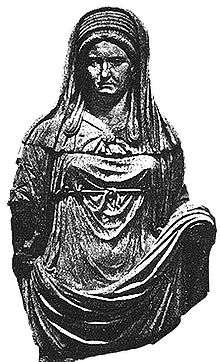
Historical religions
In historical polytheism, a priest administers the sacrifice to a deity, often in highly elaborate ritual. In the Ancient Near East, the priesthood also acted on behalf of the deities in managing their property.
Priestesses in antiquity often performed sacred prostitution, and in Ancient Greece, some priestesses such as Pythia, priestess at Delphi, acted as oracles.
Ancient priests and priestesses
- Sumerian and Akkadian Entu or EN were top-ranking priestesses who were distinguished with special ceremonial attire and held equal status to high priests. They owned property, transacted business, and initiated the hieros gamos ceremony with priests and kings.[3]
- Nadītu served as priestesses in the temples of Inanna in the ancient city of Erech. They were recruited from the highest families in the land and were supposed to remain childless, owned property, and transacted business.
- The Sumerian word NIN, EREŠ in Akkadian, is the sign for "lady." NIN.DINGIR (Akkadian entu) "divine lady," a priestess.
- In Sumerian epic texts such as Enmerkar and the Lord of Aratta, Nu-Gig were priestesses in temples dedicated to Inanna and may be a reference to the goddess herself.[4]
- Puabi of Ur was a Semitic Akkadian queen or a priestess. In several other Sumerian city-states, the ruling governor or king was also a head priest with the rank of ensi, such as at Lagash.
- Control of the "holy" city of Nippur and its temple priesthood generally meant hegemony over most of Sumer, as listed on the Sumerian King List; at one point, the Nippur priesthood conferred the title of queen of Sumer on Kugbau, a popular taverness from nearby Kish (who was later deified as Kubaba).
- In the Hebrew Bible, (קדשה) Qedesha or Kedeshah,[5] derived from the root Q-D-Š[6][7] were temple prostitutes usually associated with the goddess Asherah.
- Quadishtu served in the temples of the Sumerian goddess Qetesh.
- Ishtaritu specialized in the arts of dancing, music, and singing and they served in the temples of Ishtar.[8]
- In the Epic of Gilgamesh, priestess Shamhat, a temple prostitute, tamed wild Enkidu after "six days and seven nights."
- En-hedu-ana, Akkadian 2285 BC – 2250 BC was the first known holder of the title, "En Priestess."
- Gerarai fourteen Athenian matrons of Dionysus who presided over sacrifices and participated in the festivals of Anthesteria.
Ancient Egypt
In Egyptian ideology, the right and obligation to interact with the gods belonged to the pharaoh. He delegated this duty to priests, who were effectively bureaucrats authorized to act on his behalf. Priests staffed temples throughout Egypt, giving offerings to the cult statues in which the gods were believed to take up residence and performing other rituals for their benefit.[9] Little is known about what training may have been required of priests, and the selection of personnel for positions was affected by a tangled set of traditions, although the pharaoh had the final say. In the New Kingdom, when temples owned great estates, the high priests of the most important cult—that of Amun at Karnak—were important political figures.[10]
High-ranking priestly roles were usually held by men. Women were generally relegated to lower positions in the temple hierarchy, although some held specialized and influential positions, especially that of the God's Wife of Amun, whose religious importance overshadowed the High Priests of Amun in the Late Period.[11]
Ancient Rome
In Ancient Rome and throughout Italy, the ancient sanctuaries of Ceres and Proserpina were invariably led by female sacerdotes, drawn from women of local and Roman elites. It was the only public priesthood attainable by Roman matrons and was held in great honor.[12][13]
Ancient Greece
- The Pythia was the title of a priestess at the very ancient temple of Delphi that was dedicated to the Earth Mother. She was widely credited for her prophecies. The priestess retained her role when the temple was rededicated to Apollo, giving her a prominence unusual for a woman in the male-dominated culture of classical Greece.
- Phrygian Sibyl was the priestess presiding over an Apollonian oracle at Phrygia, a historical kingdom in the Anatolian highlands.
Abrahamic religions
Judaism
In ancient Israel the priests were required by the Law of Moses to be of direct paternal descendency from Aaron, Moses' elder brother. In Exodus 30:22–25 God instructs Moses to make a holy anointing oil to consecrate the priests "for all of eternity." During the times of the two Jewish Temples in Jerusalem, the Aaronic priests were responsible for the daily and special Jewish holiday offerings and sacrifices within the temples, these offerings are known as the korbanot.
In Hebrew the word "priest" is kohen (singular כהן kohen, plural כּהנִים kohanim), hence the family names Cohen, Cahn, Kahn, Kohn, Kogan, etc. These families are from the tribe of Levi (Levites) and in twenty-four instances are called by scripture as such (Jerusalem Talmud to Mishnaic tractate Maaser Sheini p. 31a). In Hebrew the word for "priesthood" is kehunnah.
Since the destruction of the Second Temple, and (therefore) the cessation of the daily and seasonal temple ceremonies and sacrifices, Kohanim in traditional Judaism (Orthodox Judaism and to some extent, Conservative Judaism) continue to perform a number of priestly ceremonies and roles such as the Pidyon HaBen (redemption of a first-born son) ceremony and the Priestly Blessing, and have remained subject, particularly in Orthodox Judaism, to a number of restrictions, such as restrictions on certain marriages and ritual purity (see Kohanic disqualifications).
Orthodox Judaism regard the kohanim as being held in reserve for a future restored Temple. In all branches of Judaism, Kohanim do not perform roles of propitiation, sacrifice, or sacrament. Rather, a kohen's principal religious function is to perform the Priestly Blessing, and, provided he is rabbinically qualified, to serve as an authoritative judge (posek) and expositor of Jewish halakha law.
Christianity

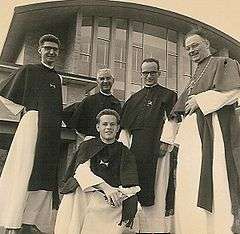
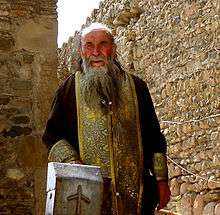
With the spread of Christianity and the formation of parishes, the Greek word ἱερεύς (hiereus), and Latin sacerdos, which Christians had since the 3rd century applied to bishops and only in a secondary sense to presbyters, began in the 6th century to be used of presbyters,[14] and is today commonly used of presbyters, distinguishing them from bishops.[15]
Today the term "priest" is used in Roman Catholicism, Eastern Orthodoxy, Anglicanism, Oriental Orthodoxy, the Church of the East, and some branches of Lutheranism to refer to those who have been ordained to a ministerial position through receiving the sacrament of Holy Orders, although "presbyter" is also used.[16] Since the Protestant Reformation, non-sacramental denominations are more likely to use the term "elder" to refer to their pastors.
However, nowhere in the New Testament is a Christian pastor (besides Christ) titled "hiereus," the distinctive Greek word for "priest," and thus its rendering into English is seen as an etymological corruption of the Greek word "presbuteros," which means "elder," and which is the word for the lead category of Christian leaders in the New Testament church,[17] under the Lord Jesus Christ, the great High Priest (archiereus). In the New Testament, it is taught that as Christ made the perfect sacrifice for the forgiveness of sins, then believers have direct access to the Father through Him, (Hebrews 10:19) with the only priesthood that is named under Christ in the church being that which consists of all believers.[18]
The New Testament Epistle to the Hebrews in particular draws a distinction between the Jewish priesthood and the high priesthood of Christ; it teaches that the sacrificial atonement by Jesus Christ on Calvary has made the Jewish priesthood and its prescribed ritual sacrifices redundant, along with the rest of the ceremonial acts of the Mosaic law, see Christian views on the Old Covenant for details. Thus, for Christians, Christ himself is the only high priest, and Christians have no priesthood independent or distinct from participation in the priesthood of Christ, the head of the Church. The one sacrifice of Christ, which he offered "once for all" (Hebrews 10:10) on the Cross, provides eternal sanctification and redemption. Roman Catholics,[19] Eastern Orthodox,[20] High Church Anglicans,[20] Lutherans, and some Methodists consider the sacrifice to be "re-presented" in the Eucharist. The Church of Jesus Christ of Latter-day Saints (LDS Church) claims to uphold all priesthood positions of the primitive gospel by the laying on of hands.
The most known form of distinctive clothing for the priest is the easily identifiable clerical collar (or Roman collar), which takes form in either the traditional cassock, or modern day clerical shirt. The typical modern version consists of a white plastic tab, inserted into a specially made collar of a black shirt, although traditional cloth collars are still worn.
Roman Catholicism and Eastern Orthodoxy
The most significant liturgical acts reserved to priests in these traditions are the administration of the Sacraments, including the celebration of the Holy Mass or Divine Liturgy (the terms for the celebration of the Eucharist in the Latin and Byzantine traditions, respectively), and the Sacrament of Reconciliation, also called Confession. The sacraments of Anointing of the Sick (Extreme Unction) and Confirmation or Chrismation are also administered by priests, though in the Western tradition Confirmation is ordinarily celebrated by a bishop. In the East, Chrismation is performed by the priest (using oil specially consecrated by a bishop) immediately after Baptism, and Unction is normally performed by several priests (ideally seven), but may be performed by one if necessary. In the West, Holy Baptism may be celebrated by anyone. The Vatican catechism states that "According to Latin tradition, the spouses as ministers of Christ's grace mutually confer upon each other the sacrament of Matrimony".[21] Thus marriage is a sacrament administered by the couple to themselves, but may be witnessed and blessed by a deacon, or priest (who usually administers the ceremony). In the East, Holy Baptism and Marriage (which is called "Crowning") may be performed only by a priest. If a person is baptized in extremis (i.e., when in fear of immediate death), only the actual threefold immersion together with the scriptural words (Matthew 28:19) may be performed by a layperson or deacon. The remainder of the rite, and Chrismation, must still be performed by a priest, if the person survives. The only sacrament which may be celebrated only by a bishop is that of Ordination (cheirotonia, "Laying-on of Hands"), or Holy Orders.
In these traditions, only men who meet certain requirements may become priests. In Roman Catholicism the canonical minimum age is twenty-five. Bishops may dispense with this rule and ordain men up to one year younger. Dispensations of more than a year are reserved to the Holy See (Can. 1031 §§1, 4.) A Catholic priest must be incardinated by his bishop or his major religious superior in order to engage in public ministry. In Orthodoxy, the normal minimum age is thirty (Can. 9 of Neocaesarea) but a bishop may dispense with this if needed. In neither tradition may priests marry after ordination. In the Roman Catholic Church, priests in the Latin Rite, which covers the vast majority of Roman Catholicism, must be celibate except under special rules for married clergy converting from certain other Christian confessions.[22] Married men may become priests in Eastern Orthodoxy and the Eastern Catholic Churches, but in neither case may they marry after ordination, even if they become widowed. Candidates for bishop are chosen only from among the celibate. Orthodox priests will either wear a clerical collar similar to the above mentioned, or simply a very loose black robe that does not have a collar.
Anglican or Episcopalian
The role of a priest in the Anglican Communion is largely the same as within the Roman Catholic Church and Eastern Christianity, except that canon law in almost every Anglican province restricts the administration of confirmation to the bishop, just as with ordination. Whilst Anglican priests who are members of religious orders must remain celibate (although there are exceptions, such as priests in the Anglican Order of Cistercians), the secular clergy—bishops, priests, and deacons who are not members of religious orders—are permitted to marry before or after ordination (although in most provinces they are not yet permitted to marry a person of the same sex.) The Anglican churches, unlike the Roman Catholic or Eastern Christian traditions, have allowed the ordination of women as priests in some provinces since 1971.[23] This practice remains controversial, however; a minority of provinces (10 out of the 38 worldwide) retain an all-male priesthood.[24] Most Continuing Anglican churches do not ordain women to the priesthood.
As Anglicanism represents a broad range of theological opinion, its presbyterate includes priests who consider themselves no different in any respect from those of the Roman Catholic Church, and a minority who prefer to use the title presbyter in order to distance themselves from the more sacrificial theological implications which they associate with the word priest. While priest is the official title of a member of the presbyterate in every Anglican province worldwide, the ordination rite of certain provinces (including the Church of England) recognizes the breadth of opinion by adopting the title The Ordination of Priests (also called Presbyters). Historically, the term priest has been more associated with the “High Church” or Anglo-Catholic wing, whereas the term “minister” has been more commonly used in “Low Church” or Evangelical circles.[25]
Protestantism
The general priesthood or the priesthood of all believers, is a Christian doctrine derived from several passages of the New Testament. It is a foundational concept of Protestantism.[26] It is this doctrine that Martin Luther adduces in his 1520 To the Christian Nobility of the German Nation in order to dismiss the medieval Christian belief that Christians were to be divided into two classes: "spiritual" and "temporal" or non-spiritual.
The conservative reforms of Lutherans are reflected in the theological and practical view of the ministry of the Church. Much of European Lutheranism follows the traditional catholic governance of deacon, priest and bishop. The Lutheran archbishops of Finland, Sweden, etc. and Baltic countries are the historic national primates (See the original Catholic Church) and some ancient cathedrals and parishes in the Lutheran church were constructed many centuries before the Reformation. Indeed, ecumenical work within the Anglican communion and among Scandinavian Lutherans mutually recognize the historic apostolic legitimacy and full communion. Likewise in America, Lutherans have embraced the apostolic succession of bishops in the full communion with Episcopalians and most Lutheran ordinations are performed by a bishop. The Roman Catholic Church, however, does not recognise Episcopalians or Lutherans as having legitimate apostolic succession.
Ordained Protestant clergy often have the title of pastor, minister, reverend, etc. In some Lutheran churches, ordained clergy are called priests, while in others the term pastor is preferred.
Latter Day Saints
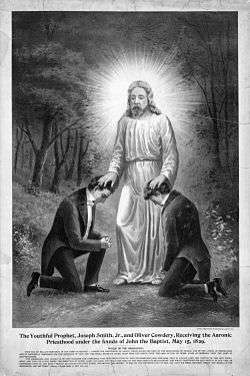
In the Latter Day Saint movement, priesthood is the power and authority of God given to man, including the authority to perform ordinances and to act as a leader in the church. A body of priesthood holders is referred to as a quorum. Priesthood denotes elements of both power and authority. The priesthood includes the power Jesus gave his apostles to perform miracles such as the casting out of devils and the healing of sick (Luke 9:1). Latter Day Saints believe that the Biblical miracles performed by prophets and apostles were performed by the power of priesthood, including the miracles of Jesus, who holds all of the keys of the priesthood. The priesthood is formally known as the "Priesthood after the Order of the Son of God", but to avoid the too frequent use of the name of deity, the priesthood is referred to as the Melchizedek priesthood (Melchizedek being the high priest to whom Abraham paid tithes). As an authority, priesthood is the authority by which a bearer may perform ecclesiastical acts of service in the name of God. Latter Day Saints believe that acts (and in particular, ordinances) performed by one with priesthood authority are recognized by God and are binding in heaven, on earth, and in the afterlife. In addition, Latter Day Saints believe that leadership positions within the church are legitimized by the priesthood authority.
Islam
Islam has no sacerdotal priesthood, as every believer (mu'min) is individually empowered to engage with God directly, without any mediator. There are, however, a variety of academic and administrative offices which have evolved to assist Muslims with this task; a full discussion can be found at Clergy#Islam.
Eastern religions
Hinduism

Hindu priests historically were members of the Brahmin caste. Priests are ordained and trained as well. There are two types of Hindu priests, pujaris and purohits. A pujari performs rituals in a temple. These rituals include bathing the murtis (the statues of the gods/goddesses), performing puja, a ritualistic offering of various items to the Gods, the waving of a ghee or oil lamp also called an offering in light, known in Hinduism as aarti, before the murtis. Pujaris are often married.
A purohit, on the other hand, performs rituals and saṃskāras (sacraments) outside of the temple. There are special purohits who perform only funeral rites.
In many cases, a purohit also functions as a pujari. Both women and men are ordained as purohits and pujaris.[27][28]
There are many priests in India who perform their work both inside and outside temples. The ones who perform it inside are called "pujaris" who are more common and are more significant in society. A few tasks of these "pujaris" would be to clean or bathe the statue of the God in the temple. They do earn from this but do not demand too much money. The other more debatable priests are the purohits who perform their duties outside the temple. They act as God for poor people and by talking or by providing 'hope', they earn a living.
Zoroastrianism
In Zoroastrianism, the priesthood is reserved for men and is a mostly hereditary position. The priests prepare a drink from a sacred plant, which is called the haoma ritual. They officiate the Yasna, pouring libations into the sacred fire to the accompaniment of ritual chants.
Taoism
The Taoist priest is called a Daoshi (道士 "master of the Dao" p. 488). Daoshi act as interpreters of the principles of Yin-Yang 5 elements (fire, water, soil, wood, and metal p. 53) school of ancient Chinese philosophy, as they relate to marriage, death, festival cycles, and so on. The Daoshi seeks to share the benefits of meditation with his or her community through public ritual and liturgy (p. 326). In the ancient priesthood before the Tang, the priest was called Jijiu ("libationer" p. 550), with both male and female practitioners selected by merit. The system gradually changed into a male only hereditary Daoshi priesthood until more recent times (p. 550,551).[29]
Indigenous and ethnic religions
Shintoism
The shinto priest is called a kannushi (神主, lit. "Master of the kami"), originally pronounced kamunushi, sometimes referred to as a shinshoku (神職). A Kannushi is the person responsible for the maintenance of a Shinto shrine, or jinja, purificatory rites, and for leading worship and veneration of a certain kami. Additionally, priests are aided by miko (巫女, "shrine maidens") for many rites as a kind of shaman or medium. The maidens may either be family members in training, apprentices, or local volunteers.
Saiin were female relatives of the Japanese emperor (termed saiō) who served as High Priestesses in Kamo Shrine. Saiō also served at Ise Shrine. Saiin priestesses usually were elected from royalty. In principle, Saiin remained unmarried, but there were exceptions. Some Saiin became consorts of the emperor, called Nyōgo in Japanese. The Saiin order of priestesses existed throughout the Heian and Kamakura periods.
Africa
The Yoruba people of western Nigeria practice an indigenous religion with a chiefly hierarchy of priests and priestesses that dates to AD 800–1000. Ifá priests and priestesses bear the titles Babalawo for men and Iyanifa for women.[30] Priests and priestesses of the varied Orisha are titled Babalorisa for men and Iyalorisa for women.[31] Initiates are also given an Orisa or Ifá name that signifies under which deity they are initiated. For example, a Priestess of Oshun may be named Osunyemi, and a Priest of Ifá may be named Ifáyemi. This ancient culture continues to this day as initiates from all around the world return to Nigeria for initiation into the traditional priesthood, and varied derivative sects in the New World (such as Cuban Santeria and Brazilian Umbanda) use the same titles to refer to their officers as well.
Neo-Paganism
Wicca
According to traditional Wiccan beliefs, every member of the religion is considered a priestess or priest, as it is believed that no person can stand between another and the Divine. However, in response to the growing number of Wiccan temples and churches, several denominations of the religion have begun to develop a core group of ordained priestesses and priests serving a larger laity. This trend is far from widespread, but is gaining acceptance due to increased interest in the religion.[32][33][34]
Dress
The dress of religious workers in ancient times may be demonstrated in frescoes and artifacts from the cultures. The dress is presumed to be related to the customary clothing of the culture, with some symbol of the deity worn on the head or held by the person. Sometimes special colors, materials, or patterns distinguish celebrants, as the white wool veil draped on the head of the Vestal Virgins.

Occasionally the celebrants at religious ceremonies shed all clothes in a symbolic gesture of purity. This was often the case in ancient times. An example of this is shown to the left on a Kylix dating from c. 500 BC where a priestess is featured. Modern religious groups tend to avoid such symbolism and some may be quite uncomfortable with the concept.
The retention of long skirts and vestments among many ranks of contemporary priests when they officiate may be interpreted to express the ancient traditions of the cultures from which their religious practices arose.
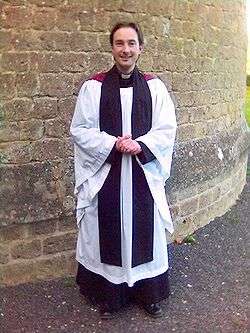
In most Christian traditions, priests wear clerical clothing, a distinctive form of street dress. Even within individual traditions it varies considerably in form, depending on the specific occasion. In Western Christianity, the stiff white clerical collar has become the nearly universal feature of priestly clerical clothing, worn either with a cassock or a clergy shirt. The collar may be either a full collar or a vestigial tab displayed through a square cutout in the shirt collar.
Eastern Christian priests mostly retain the traditional dress of two layers of differently cut cassock: the rasson (Greek) or podriasnik (Russian) beneath the outer exorasson (Greek) or riasa (Russian). If a pectoral cross has been awarded it is usually worn with street clothes in the Russian tradition, but not so often in the Greek tradition.
Distinctive clerical clothing is less often worn in modern times than formerly, and in many cases it is rare for a priest to wear it when not acting in a pastoral capacity, especially in countries that view themselves as largely secular in nature. There are frequent exceptions to this however, and many priests rarely if ever go out in public without it, especially in countries where their religion makes up a clear majority of the population. Pope John Paul II often instructed Catholic priests and religious to always wear their distinctive (clerical) clothing, unless wearing it would result in persecution or grave verbal attacks.
Christian traditions that retain the title of priest also retain the tradition of special liturgical vestments worn only during services. Vestments vary widely among the different Christian traditions.
In modern Pagan religions, such as Wicca, there is no one specific form of dress designated for the clergy. If there is, it is a particular of the denomination in question, and not a universal practice. However, there is a traditional form of dress, (usually a floor-length tunic and a knotted cord cincture, known as the cingulum), which is often worn by worshipers during religious rites. Among those traditions of Wicca that do dictate a specific form of dress for its clergy, they usually wear the traditional tunic in addition to other articles of clothing (such as an open-fronted robe or a cloak) as a distinctive form of religious dress, similar to a habit.
Assistant priest
In many religions there are one or more layers of assistant priests.
In the Ancient Near East, hierodules served in temples as assistants to the priestess.
In ancient Judaism, the Priests (Kohanim) had a whole class of Levites as their assistants in making the sacrifices, in singing psalms and in maintaining the Temple. The Priests and the Levites were in turn served by servants called Nethinim. These lowest level of servants were not priests.
An assistant priest is a priest in the Anglican and Episcopal churches who is not the senior member of clergy of the parish to which they are appointed, but is nonetheless in priests' orders; there is no difference in function or theology, merely in 'grade' or 'rank'. Some assistant priests have a "sector ministry", that is to say that they specialize in a certain area of ministry within the local church, for example youth work, hospital work, or ministry to local light industry. They may also hold some diocesan appointment part-time. In most (though not all) cases an assistant priest has the legal status of assistant curate, although it should also be noted that not all assistant curates are priests, as this legal status also applies to many deacons working as assistants in a parochial setting.
The corresponding term in the Catholic Church is "parochial vicar" – an ordained priest assigned to assist the pastor (Latin: parochus) of a parish in the pastoral care of parishioners. Normally, all pastors are also ordained priests; occasionally an auxiliary bishop will be assigned that role.
In Wicca, the leader of a coven or temple (either a high priestess or high priest) often appoints an assistant. This assistant is often called a 'deputy', but the more traditional terms 'maiden' (when female and assisting a high priestess) and 'summoner' (when male and assisting a high priest) are still used in many denominations.
See also
- Archpriest
- Brahmin
- Clergy
- Hieromonk
- Holy Orders
- List of fictional clergy and religious figures
- Mobad
- Oracle
- Ordination of women
- Pastor
- Presbyterorum Ordinis, decree on the priesthood from the Second Vatican Council
- Priest shortage
- Priesthood (Latter Day Saints)
- Priesthood (Orthodox Church)
- Ritualism
- Sacerdotalism
- Shaman
- Vedic priesthood
- Vicar
References
- ↑ Webster's New World Dictionary of the American Language, College Edition, The World Publishing Company, Cleveland OH, s.v. "priest"
- ↑ Joseph B. Lightfoot, Epistle to the Philippians; a revised text, with introduction, etc., 2nd ed. 1869, p. 184, cited after OED.
- ↑ Dening, Sarah (1996). The Mythology of Sex – Ch.3. Macmillan. ISBN 978-0-02-861207-2.
- ↑ Black, Jeremy (1998). Reading Sumerian Poetry. Cambridge University Press. p. 142. ISBN 0-485-93003-X.
- ↑ "Hebrew Lexicon :: H6948 (KJV)". cf.blueletterbible.org. Retrieved 2015-07-25.
- ↑ Blue Letter Bible, Lexicon results for qĕdeshah (Strong's H2181), incorporating Strong's Concordance (1890) and Gesenius's Lexicon (1857).
- ↑ Also transliterated qĕdeshah, qedeshah, qědēšā ,qedashah, kadeshah, kadesha, qedesha, kdesha. A modern liturgical pronunciation would be k'deysha
- ↑ Prioreschi, Plinio (1991). A History of Medicine. Horatius Press. p. 376. ISBN 1-888456-00-0.
- ↑ Sauneron, Serge (2000) [1988]. The Priests of Ancient Egypt, New Edition. Translated by David Lorton. Cornell University Press. pp. 32–36, 89–92
- ↑ Sauneron 2000, pp. 42–47, 52–53
- ↑ Doxey, Denise M., "Priesthood", in The Oxford Encyclopedia of Ancient Egypt (2001), vol. III, pp. 69–70
- ↑ A Roman matron was any mature woman of the upper class, married or unmarried. Females could serve public cult as Vestal Virgins but few were chosen, and then only from young maidens of the upper class.
- ↑ Barbette Stanley Spaeth, The Roman goddess Ceres, University of Texas Press, 1996, pp. 4–5, 9, 20 (historical overview and Aventine priesthoods), 84–89 (functions of plebeian aediles), 104–106 (women as priestesses): citing among others Cicero, In Verres, 2.4.108; Valerius Maximus, 1.1.1; Plutarch, De Mulierum Virtutibus, 26.
- ↑ Garhammer, Erich (2005). "Priest, Priesthood 3. Roman Catholicism". In Erwin Fahlbusch. Encyclopedia of Christianity. 4. Wm. B. Eerdmans Publishing. p. 348. ISBN 9780802824165. Retrieved 2012-06-20.
- ↑ "Dennis Chester Smolarski, ''Sacred Mysteries'' (Paulist Press 1995 ISBN 9780809135516), p. 128". Google.com. Retrieved 2014-08-25.
- ↑ An example of the use of "presbyter" is found in Catechism of the Catholic Church, 1554
- ↑ Buchanan, Colin (February 27, 2006). Historical Dictionary of Anglicanism. USA: Scarecrow Press. p. 367. ISBN 978-0810853270.
- ↑ Merkle, Benjamin L. (November 29, 2007). 40 Questions about Elders and Deacons. Grand Rapids, MI: November 29, 2007. pp. 52, 53. ISBN 978-0825433641.
- ↑ "Catechism of the Catholic Church, 1362–1367". Vatican.va. Retrieved 2014-08-25.
- 1 2 "Peter M. Doll, ''Anglicanism and Orthodoxy'' (Peter Lang 2006 ISBN 9783039105809), pp. 206–207". Google.com. Retrieved 2014-08-25.
- ↑ "Catechism of the Catholic Church – The sacrament of Matrimony". vatican.va. Retrieved 2015-07-25.
- ↑ Miller, Michael (May 17, 2008). "Peoria diocese ordains its first married priest". Peoria Journal Star. p. C8. Archived from the original on 2013-06-01. Retrieved 2013-06-14.
About 100 Episcopal priests, many of them married, have become Roman Catholic priests since a "pastoral provision" was created by Pope John Paul II in 1980, said [Doug] Grandon, director of catechetics for the diocese. [...] His family life will remain the same, he said. Contrary to popular misunderstandings, he won't have to be celibate.
- ↑ Emma John (July 4, 2010). "Should women ever be bishops?". The Observer. London.
- ↑ Sulaiman Kakaire. "Male bishops speak out on female priests".
- ↑ Anglican Church of Canada. "Minister or Priest?".
- ↑ "The Protestant Heritage". Encyclopædia Britannica. 2007. Archived from the original on June 14, 2006. Retrieved 2007-09-20.
- ↑ Lew, Irene (2008-02-26). "Indian City Opens Doorway to Female Hindu Priests". Womens eNews. Retrieved 2014-08-25.
- ↑ Mathai, Kamini (2008-10-18). "Masti, mehendi mark Karva Chauth in city [Chennai]". The Times of India.
- ↑ Pregadio, Fabrizio (2008) The Encyclopedia of Taoism, Volume 1 Psychology Press ISBN 0700712003
- at Google books: pages 488–490 • pages 53,54 • pages 326–329 • pages 550,551
- ↑ Asante, M.K.; Mazama, A. (2009). Encyclopedia of African Religion. 1. SAGE Publications. ISBN 9781412936361. Retrieved 2015-07-25.
- ↑ Walter, M.N.; Fridman, E.J.N. (2004). Shamanism: An Encyclopedia of World Beliefs, Practices, and Culture. 1. ABC-CLIO. p. 451. ISBN 9781576076453. Retrieved 2015-07-25.
- ↑ "Priesthood". Paganwiccan.about.com. 2014-03-04. Retrieved 2014-08-25.
- ↑ "Leadership". Patheos.com. Retrieved 2014-08-25.
- ↑ "The Priesthood – Temple of the Good Game". Goodgame.org.nz. Retrieved 2014-08-25.
External links
| Look up priest in Wiktionary, the free dictionary. |
| Wikimedia Commons has media related to Priests. |
| Wikiquote has quotations related to: Priest |
- Description of the problem of Roman Catholic and Old Catholic reunion with respect to the female priesthood
-
 Chisholm, Hugh, ed. (1911). "Priest". Encyclopædia Britannica (11th ed.). Cambridge University Press.
Chisholm, Hugh, ed. (1911). "Priest". Encyclopædia Britannica (11th ed.). Cambridge University Press. -
 Herbermann, Charles, ed. (1913). "Priest". Catholic Encyclopedia. New York: Robert Appleton Company.
Herbermann, Charles, ed. (1913). "Priest". Catholic Encyclopedia. New York: Robert Appleton Company.
